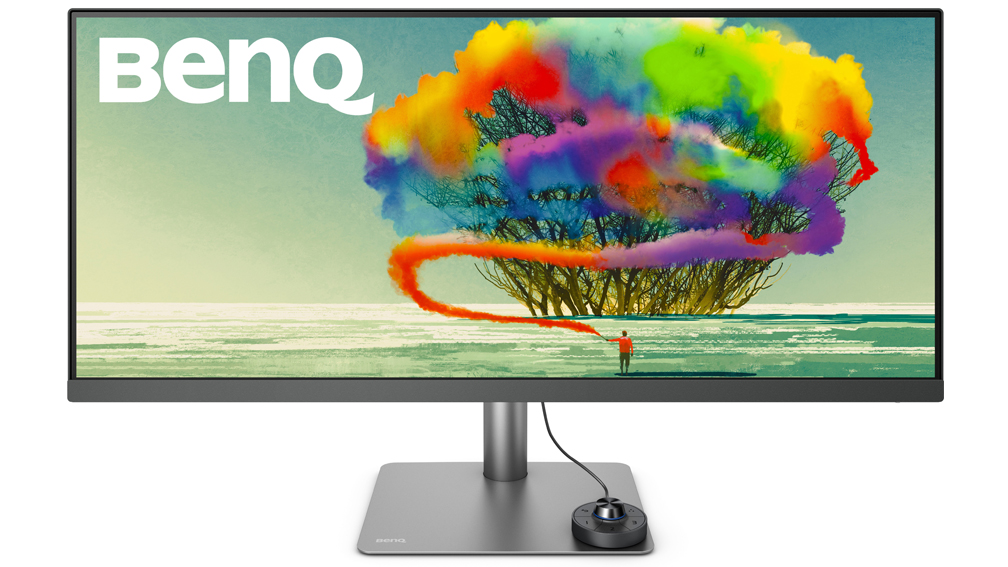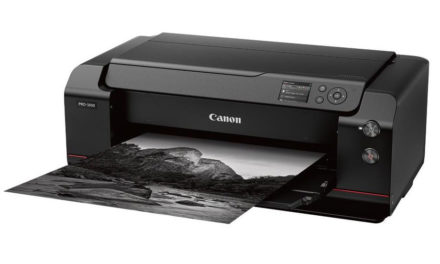Impressive Ultrawide 34” Display
Review by Steve Baczewski
The 2K, PD (Professional Design) 3420Q from BenQ has a display size that’s an impressive 34 inches. The impact of its size is further enhanced by the monitor’s thin, black bezel on the top and sides, and placement of the four button OSM (onscreen manager) on the back, which gives the screen a clean elegant look.
The PD3420Q has a resolution of 3440×1440, a 21:9 aspect ratio, with a 60-Hz refresh rate, and a 10-bit IPS screen architecture. It has a contrast ratio of 1000:1, a peak brightness of 400 candelas, and a delta E of < 3. It’s able to achieve 100% sRGB, 100% Rec. 709, and 98% DCI-P3 color gamut. After calibration, I got 80% Adobe RGB. I printed a reference test target, and was impressed by how good the screen-to-print match is.
In the screen’s “gamut duo” mode, the screen can be divided in half and assigned separate color modes. BenQ also has made available their Display Pilot software for download to further aid in partitioning and customizing the screen’s real estate. The large screen real estate makes it ideal for long timeline video editing, partitioning the desktop, working simultaneously on images having both Lightroom and Photoshop open, or editing multiple Office documents. It comes with all the necessary cables, power cord, and the second generation of BenQ’s handy Hotkey Puck G2. The Hotkey Puck has several programmable buttons that allow you to bypass the rear OSM and cycle between different color modes, adjust brightness, switch from color to black-and-white, and much more. Unlike BenQ’s SW display line, the PD lineup doesn’t include a built-in LUT or support their Master Element calibration software.

The screen sits solidly on its stand with smooth movements that include swivel, tilt, and rise-and-fall. Because of its size, there’s no rotation going from landscape to portrait mode. Once adjusted, the screen doesn’t drift. On the back and left side is a comprehensive set of I/O ports, including two v2.0 HDMI ports; one DisplayPort v1.4; one USB C port capable of delivering 65W, which is enough for most laptops; and three USB 3.1 downstream and one USB Type B upstream. It has two, 2.5-W built-in speakers and a headphone jack. The OSM includes a four-way toggle switch for navigating the comprehensive set of features built into the display. This includes several color mode presets, such as Animation, Darkroom, M-Book (M for Mac laptops), and CAD/CAM.
The PD3420’s non-glare matte screen decreases ambient light distractions; however, unlike BenQ’s SW displays, it doesn’t come with a hood for best viewing conditions.
Its 10-bit IPS panel design has a viewing angle of approximately 170° that makes it ideal for collaborative efforts, e.g., people standing around the display can still view the same color and brightness that the person seated directly in front gets. To test uniformity of brightness and color, I divided up the display into a grid of equal-sized, square spaces, and used a colorimeter to measure the brightness and color. Except for some minimal falloff at the bottom edge, its backlit LED was consistent from edge to edge.
I liked working with the BenQ PD3420Q and found it very practical for having several windows open simultaneously. It comes calibrated from the factory; displays colors accurately, with rich saturation; type is clearly defined; and working with both Lightroom and Photoshop open is a pleasure. Potential buyers best double-check to see if their workspace is sufficient for its size, though. ■






